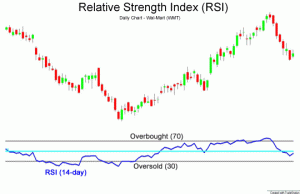Relative Strength Index (RSI)
Trading Forex with Technical Analysis Using the Relative Strength Index (RSI)
 Forex traders use a number of different strategies to minimise risk and maximise profit. Trading using the RSI, or relative strength index, has proven to be one of the most popular. Traders new to the Forex markets may be uncertain how to take advantage of this tactic and it is important to understand some of the fundamentals behind the RSI and its relevance to traders.
Forex traders use a number of different strategies to minimise risk and maximise profit. Trading using the RSI, or relative strength index, has proven to be one of the most popular. Traders new to the Forex markets may be uncertain how to take advantage of this tactic and it is important to understand some of the fundamentals behind the RSI and its relevance to traders.
The RSI provides the trader with entry and exit points regarding when to buy and sell currencies. Essentially, the RSI measures a market’s relative strength or weakness. If a Forex trader knows when a market is about to post significant gains or suffer losses, he can be greatly assisted in his open positions. To do this, the RSI calculates gains and losses in the past fourteen trading sessions on average. These parameters can be adjusted to include shorter time periods to make analyses more sensitive or adapted for longer periods to decrease sensitivity and identify longitudinal trends.
The RSI is defined as an oscillator because the chart represents one single oscillating curve containing peaks and troughs. Often times a red line can be seen directly above this main curve which represents what is called the exponential moving average, or EMA for short. This line serves to highlight the overall directions of trading signals. One should be prudent not to view these charts as completely accurate data; instead these charts are known as leading indicators. They are a tool used to signal that a change is imminent rather than that a change is present occurring. Therefore, the strength relies in short-term prediction as opposed to present values.
The RSI is based on a scale from 0 to 100, the two important levels within this margin being 70 and 30. These numbers are far from arbitrary, as 70 reflects an overbought position (signaling an imminent downward recorrection) and 30 signifies an oversold condition (an upward correction is due). Although these tend to be reliable levels, some traders substitute 30 and 70 with 20 and 80; their strategy being that a trend reversal may be due at any moment and such a reversal may be more significant than that at lower levels.
Most traders should know the formulaic background behind the RSI. This strategy uses three straightforward steps as seen below:
· The determined time period (14 sessions as a benchmark)
· Relative strength (the number periods with higher closes divided by the number of periods with lower closes)
· RSI equals 100 divided by this figure.
Using the RSI is simple and by following movements over specific periods of time, even the novice trader can become aware when to contemplate a long or short trading position.
>> Read more about Technical analysis





